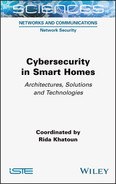Smart homes use Internet-connected devices, artificial intelligence, protocols and numerous technologies to enable people to remotely monitor their home, as well as manage various systems within it via the Internet using a smartphone or a computer. A smart home is programmed to act autonomously to improve comfort levels, save energy and potentially ensure safety; the result is a better way of life. Innovative solutions continue to be developed by researchers and engineers and thus smart home technologies are constantly evolving. By the same token, cybercrime is also becoming more prevalent. Indeed, a smart home system is made up of connected devices that cybercriminals can infiltrate to access private information, commit cyber vandalism or infect devices using botnets. This book addresses cyber attacks such as sniffing, port scanning, address spoofing, session hijacking, ransomware and denial of service. It presents, analyzes and discusses the various aspects of cybersecurity as well as solutions proposed by the research community to counter the risks. Cybersecurity in Smart Homes is intended for people who wish to understand the architectures, protocols and different technologies used in smart homes.
Table of Contents
- Cover
- Title Page
- Copyright
- 1 Home Automation Solutions for SecureWSN
- 2 Smart Home Device Security: A Survey of Smart Home Authentication Methods with a Focus on Mutual Authentication and Key Management Practices
- 3 SRAM Physically Unclonable Functions for Smart Home IoT Telehealth Environments
- 4 IoT Network Security in Smart Homes
- 5 IoT in a New Age of Unified and Zero-Trust Networks and Increased Privacy Protection
- 6 IOT, Deep Learning and Cybersecurity in Smart Homes: A Survey
- 7 sTiki: A Mutual Authentication Protocol for Constrained Sensor Devices
- List of Authors
- Index
- End User License Agreement
